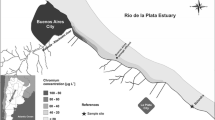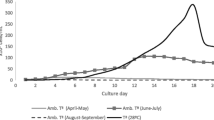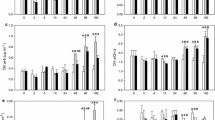Abstract
The acute toxicity of glyphosate herbicide was tested on the four species of freshwater phytoplankton, Scenedesmus acutus, Scenedesmus subspicatus, Chlorella vulgaris and Chlorella saccharophila. Herbicide concentrations eliciting a 50% growth reduction over 72 h (EC50) ranged from 24.5 to 41.7 mg L−1, whilst a 10% growth inhibition is achieved by herbicide concentrations ranging from 1.6 to 3.0 mg L−1, difficult to find neither in paddy fields (it is not used in rice) nor in the lake of the Albufera Natural Park. Chorella species are less sensitive to the herbicide than Scenedesmus species. It can be concluded that glyphosate has a low potential risk for the tested organisms.
Similar content being viewed by others
References
Aguayo S, Roset J, De la Torre AI, Cuellar ML, Muñoz MJ (2000) Ensayo de ecotoxicidad miniaturizado en Chorella vulgaris utilizando diferentes parámetros de expresión. Rev Toxicol 17:41–45
ASTM (1997) Standard guide for conducting static 96-h toxicity tests with microalgae, E 1218-97a
Carrasco JM, Sabater C (1997) Toxicity of atrazine and chlorsulfuron to algae. Toxicol Environ Chem 59:89–99. doi:10.1080/02772249709358427
Chen Y, Chiang H, Wu L, Wang Y (1985) Effects of glyphosate on germination and seedling growth of rice. J Weed Sci Tech 30:219–223
Christy SL, Karlander EP, Parochetti JV (1981) Effects of glyphosate on the growth rate of Chlorella. Weed Sci 29(1):5–7
Comoretto L, Arfib B, Chiron S (2007) Pesticides in the Rhone river delta (France): basic data for a field-based exposure assessment. Sci Total Environ 380:124–132. doi:10.1016/j.scitotenv.2006.11.046
De Paz JM, Rubio JL (2006) Application of a GIS-AF/RF model to asses the risk of herbicide leaching in a citrus-growing area of the Valencia Community, Spain. Sci Total Environ 371:44–54. doi:10.1016/j.scitotenv.2006.07.018
Durkin PR (2003) Glyphosate, Human health and ecological risk assessment. USDA forest service. http://www.fs.fed.us/foresthealth/pesticide/pdfs/04a03_glyphosate.pdf. Accessed 3 Sept 2008
Eijsackers H (1985) Effects of glyphosate on the soil fauna. In: Grossbard E, Atkinson D (eds) The herbicide glyphosate. Butterworths, London, p 151
Giesy JP, Dobson S, Solomon KR (2000) Ecotoxicological risk assessment for roundup herbicide. Rev Contam Toxicol 167:35–120
Gómez de Barreda Ferraz D, Sabater C, Carrasco JM (2004) Effects of propanil, tebufenozide and mefenacet on growth of tour freshwater species of phytoplankton: a microplate bioassay. Chemosphere 56:315–320. doi:10.1016/j.chemosphere.2004.01.038
Hernando F, Royuela M, Muñoz-Rueda A, Gonzalez Murua C (1989) Effect of Glyphosate on the greening process and photosynthetic in Chlorella pyrenoidosa. J Plant Physiol 134:26–31
Källqvist T, Romstad R (1994) Effects of agricultural pesticides on planktonic algae and cyanobacteria, examples of interspecies sensitivity variations. Nor J Agric Sci 13:117–131
Kassai F, Hatakeyama S (1993) Herbicide susceptibility in two green algae, Chorella vulgaris and Selenastrum capricornutum. Chemosphere 27:899–904. doi:10.1016/0045-6535(93)90019-2
Newman MC (1995) Quantitative methods in aquatic ecotoxicology. Lewis Publishers, London
Reish DL, Oshida P (1987) Manual of methods in aquatic environment research. Part 10, Short-Term static bioassays. FAO Fisheries Technical Paper 247. Food and Agriculture Organization of the United Nations
Rueppel ML, Brightwell BB, Schaefer J, Marvel JT (1977) Metabolism and degradation of glyphosate in soil and water. J Agric Food Chem 25:517–528. doi:10.1021/jf60211a018
Sabater C, Carrasco JM (1996) Effects of thiobencarb on the growth of three species of phytoplankton. Bull Environ Contam Toxicol 56:977–981. doi:10.1007/s001289900141
Sabater C, Carrasco JM (1997) Effects of chlorsulfuron on growth of three freshwater species of phytoplankton. Bull Environ Contam Toxicol 58:807–813. doi:10.1007/s001289900406
Sabater C, Carrasco JM (1998) Effects of molinate on growth of five freshwater species of phytoplankton. Bull Environ Contam Toxicol 61:534–540. doi:10.1007/s001289900795
Sabater C, Cuesta A, Carrasco R (2002) Effects of bensulfuron–methyl and cinosulfuron on growth of four freshwater species of phytoplankton. Chemosphere 46:953–960. doi:10.1016/S0045-6535(01)00179-5
Sáenz ME, Accorinti J, Tortorelli MC (1993) Toxicity of paraquat to a green alga, Scenedesmus acutus. J Environ Sci Health B 28:193–240. doi:10.1080/03601239309372822
Sáenz ME, Alberdi JL, Dimarzio WD, Accorinti J, Tortorelli MC (1997) Paraquat toxicity to different green algae. Bull Environ Contam Toxicol 58:922–928
SAS (1988) SAS/STAT User’s Guide: statistics. Version 5. SAS Institute Inc, NC
Sloof W, Canton JH, Hermens JLM (1983) Comparison of the susceptibility of 22 freshwater species to 15 chemical compounds. I. (Semi) acute toxicity tests. Aquat Toxicol 4:113–128. doi:10.1016/0166-445X(83)90049-8
Solomon KR, Thompson DG (2003) Ecological risk assessment for aquatic organisms from over-water uses of glyphosate. J Toxicol Environ Health B 6:289–324. doi:10.1080/10937400306468
Sprankle P, Meggitt WF, Penner D (1975) Adsorption, mobility and microbial degradation of glyphosate in the soil. Weed Sci 23:229–234
STATGRAPHICS (1994) Statistical Corp. Version 2.1. STSC Inc., Md
Torstensson L (1985) Behaviour of glyphosate in soils and its degradation. In: Grossbard E, Atkinson D (eds) The herbicide glyphosate. Butterworths, London, p 137
Wong P (2000) Effects of 2, 4-D, glyphosate and paraquat on growth, photosynthesis and chlorophyll—a synthesis of Scenedesmus quadricauda. Chemosphere 41:177–182. doi:10.1016/S0045-6535(99)00408-7
Acknowledgments
This work was supported by a grant from “Comisión Interministerial de Ciencia y Tecnología, AGL-2002-04532-C03-01”.
Author information
Authors and Affiliations
Corresponding author
Rights and permissions
About this article
Cite this article
Vendrell, E., Gómez de Barreda Ferraz, D., Sabater, C. et al. Effect of Glyphosate on Growth of Four Freshwater Species of Phytoplankton: A Microplate Bioassay. Bull Environ Contam Toxicol 82, 538–542 (2009). https://doi.org/10.1007/s00128-009-9674-z
Received:
Accepted:
Published:
Issue Date:
DOI: https://doi.org/10.1007/s00128-009-9674-z




